Jinjian Wu
Optimizing Multi-Modal Trackers via Sensitivity-aware Regularized Tuning
Aug 24, 2025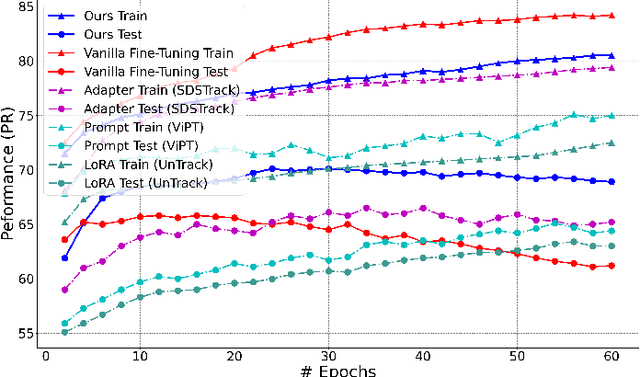
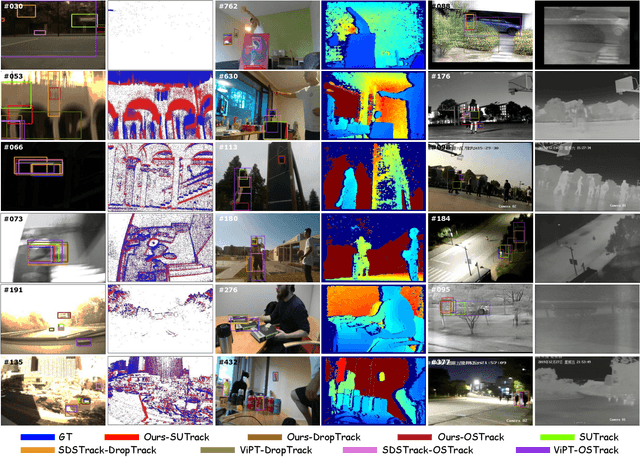
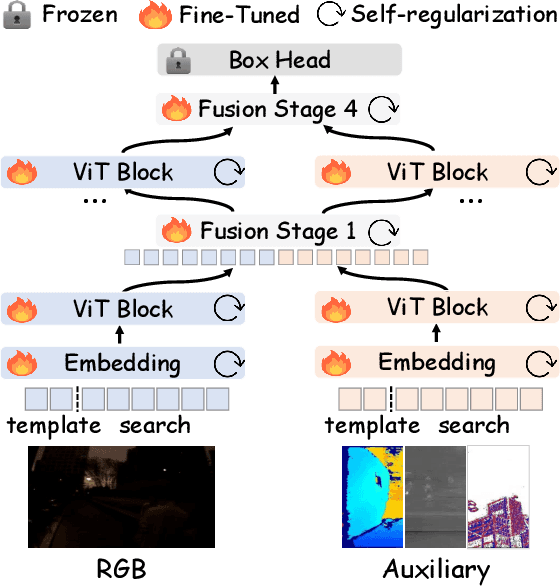
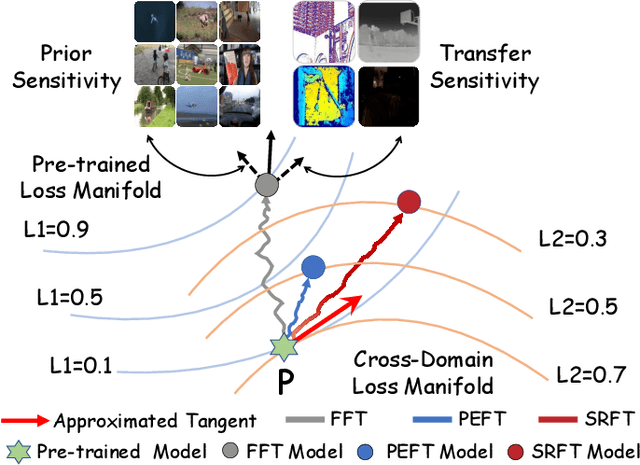
Abstract:This paper tackles the critical challenge of optimizing multi-modal trackers by effectively adapting the pre-trained models for RGB data. Existing fine-tuning paradigms oscillate between excessive freedom and over-restriction, both leading to a suboptimal plasticity-stability trade-off. To mitigate this dilemma, we propose a novel sensitivity-aware regularized tuning framework, which delicately refines the learning process by incorporating intrinsic parameter sensitivities. Through a comprehensive investigation from pre-trained to multi-modal contexts, we identify that parameters sensitive to pivotal foundational patterns and cross-domain shifts are primary drivers of this issue. Specifically, we first analyze the tangent space of pre-trained weights to measure and orient prior sensitivities, dedicated to preserving generalization. Then, we further explore transfer sensitivities during the tuning phase, emphasizing adaptability and stability. By incorporating these sensitivities as regularization terms, our method significantly enhances the transferability across modalities. Extensive experiments showcase the superior performance of the proposed method, surpassing current state-of-the-art techniques across various multi-modal tracking. The source code and models will be publicly available at https://github.com/zhiwen-xdu/SRTrack.
Language-Guided Visual Perception Disentanglement for Image Quality Assessment and Conditional Image Generation
Mar 04, 2025Abstract:Contrastive vision-language models, such as CLIP, have demonstrated excellent zero-shot capability across semantic recognition tasks, mainly attributed to the training on a large-scale I&1T (one Image with one Text) dataset. This kind of multimodal representations often blend semantic and perceptual elements, placing a particular emphasis on semantics. However, this could be problematic for popular tasks like image quality assessment (IQA) and conditional image generation (CIG), which typically need to have fine control on perceptual and semantic features. Motivated by the above facts, this paper presents a new multimodal disentangled representation learning framework, which leverages disentangled text to guide image disentanglement. To this end, we first build an I&2T (one Image with a perceptual Text and a semantic Text) dataset, which consists of disentangled perceptual and semantic text descriptions for an image. Then, the disentangled text descriptions are utilized as supervisory signals to disentangle pure perceptual representations from CLIP's original `coarse' feature space, dubbed DeCLIP. Finally, the decoupled feature representations are used for both image quality assessment (technical quality and aesthetic quality) and conditional image generation. Extensive experiments and comparisons have demonstrated the advantages of the proposed method on the two popular tasks. The dataset, code, and model will be available.
E-Motion: Future Motion Simulation via Event Sequence Diffusion
Oct 11, 2024Abstract:Forecasting a typical object's future motion is a critical task for interpreting and interacting with dynamic environments in computer vision. Event-based sensors, which could capture changes in the scene with exceptional temporal granularity, may potentially offer a unique opportunity to predict future motion with a level of detail and precision previously unachievable. Inspired by that, we propose to integrate the strong learning capacity of the video diffusion model with the rich motion information of an event camera as a motion simulation framework. Specifically, we initially employ pre-trained stable video diffusion models to adapt the event sequence dataset. This process facilitates the transfer of extensive knowledge from RGB videos to an event-centric domain. Moreover, we introduce an alignment mechanism that utilizes reinforcement learning techniques to enhance the reverse generation trajectory of the diffusion model, ensuring improved performance and accuracy. Through extensive testing and validation, we demonstrate the effectiveness of our method in various complex scenarios, showcasing its potential to revolutionize motion flow prediction in computer vision applications such as autonomous vehicle guidance, robotic navigation, and interactive media. Our findings suggest a promising direction for future research in enhancing the interpretative power and predictive accuracy of computer vision systems.
Bridging the Synthetic-to-Authentic Gap: Distortion-Guided Unsupervised Domain Adaptation for Blind Image Quality Assessment
May 07, 2024Abstract:The annotation of blind image quality assessment (BIQA) is labor-intensive and time-consuming, especially for authentic images. Training on synthetic data is expected to be beneficial, but synthetically trained models often suffer from poor generalization in real domains due to domain gaps. In this work, we make a key observation that introducing more distortion types in the synthetic dataset may not improve or even be harmful to generalizing authentic image quality assessment. To solve this challenge, we propose distortion-guided unsupervised domain adaptation for BIQA (DGQA), a novel framework that leverages adaptive multi-domain selection via prior knowledge from distortion to match the data distribution between the source domains and the target domain, thereby reducing negative transfer from the outlier source domains. Extensive experiments on two cross-domain settings (synthetic distortion to authentic distortion and synthetic distortion to algorithmic distortion) have demonstrated the effectiveness of our proposed DGQA. Besides, DGQA is orthogonal to existing model-based BIQA methods, and can be used in combination with such models to improve performance with less training data.
Denoising Distillation Makes Event-Frame Transformers as Accurate Gaze Trackers
Mar 31, 2024



Abstract:This paper tackles the problem of passive gaze estimation using both event and frame data. Considering inherently different physiological structures, it's intractable to accurately estimate purely based on a given state. Thus, we reformulate the gaze estimation as the quantification of state transitions from the current state to several prior registered anchor states. Technically, we propose a two-stage learning-based gaze estimation framework to divide the whole gaze estimation process into a coarse-to-fine process of anchor state selection and final gaze location. Moreover, to improve generalization ability, we align a group of local experts with a student network, where a novel denoising distillation algorithm is introduced to utilize denoising diffusion technique to iteratively remove inherent noise of event data. Extensive experiments demonstrate the effectiveness of the proposed method, which greatly surpasses state-of-the-art methods by a large extent of 15$\%$. The code will be publicly available at https://github.com/jdjdli/Denoise_distill_EF_gazetracker.
Fast Window-Based Event Denoising with Spatiotemporal Correlation Enhancement
Feb 14, 2024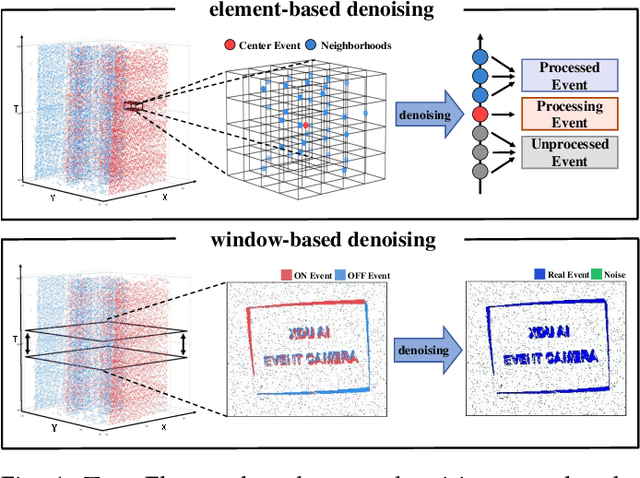
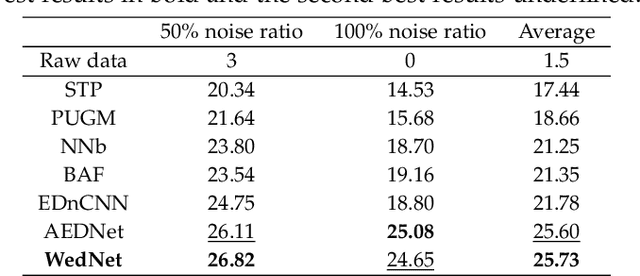
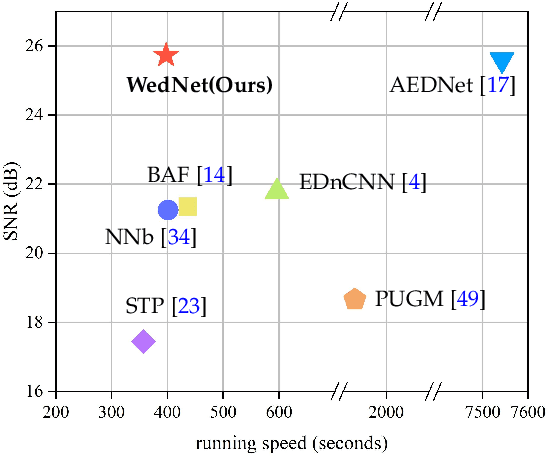

Abstract:Previous deep learning-based event denoising methods mostly suffer from poor interpretability and difficulty in real-time processing due to their complex architecture designs. In this paper, we propose window-based event denoising, which simultaneously deals with a stack of events while existing element-based denoising focuses on one event each time. Besides, we give the theoretical analysis based on probability distributions in both temporal and spatial domains to improve interpretability. In temporal domain, we use timestamp deviations between processing events and central event to judge the temporal correlation and filter out temporal-irrelevant events. In spatial domain, we choose maximum a posteriori (MAP) to discriminate real-world event and noise, and use the learned convolutional sparse coding to optimize the objective function. Based on the theoretical analysis, we build Temporal Window (TW) module and Soft Spatial Feature Embedding (SSFE) module to process temporal and spatial information separately, and construct a novel multi-scale window-based event denoising network, named MSDNet. The high denoising accuracy and fast running speed of our MSDNet enables us to achieve real-time denoising in complex scenes. Extensive experimental results verify the effectiveness and robustness of our MSDNet. Our algorithm can remove event noise effectively and efficiently and improve the performance of downstream tasks.
Self-supervised Learning of LiDAR 3D Point Clouds via 2D-3D Neural Calibration
Jan 23, 2024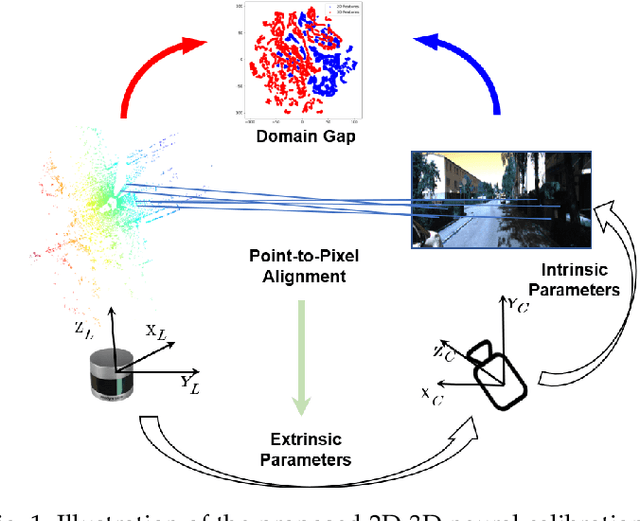
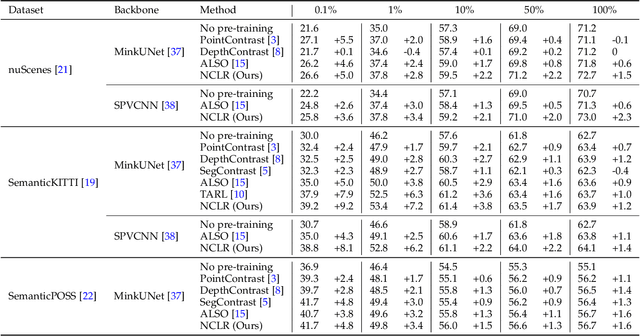
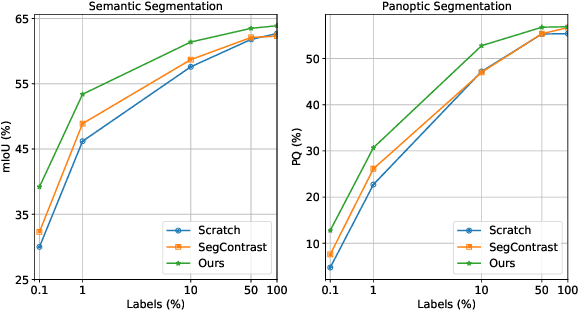

Abstract:This paper introduces a novel self-supervised learning framework for enhancing 3D perception in autonomous driving scenes. Specifically, our approach, named NCLR, focuses on 2D-3D neural calibration, a novel pretext task that estimates the rigid transformation aligning camera and LiDAR coordinate systems. First, we propose the learnable transformation alignment to bridge the domain gap between image and point cloud data, converting features into a unified representation space for effective comparison and matching. Second, we identify the overlapping area between the image and point cloud with the fused features. Third, we establish dense 2D-3D correspondences to estimate the rigid transformation. The framework not only learns fine-grained matching from points to pixels but also achieves alignment of the image and point cloud at a holistic level, understanding their relative pose. We demonstrate NCLR's efficacy by applying the pre-trained backbone to downstream tasks, such as LiDAR-based 3D semantic segmentation, object detection, and panoptic segmentation. Comprehensive experiments on various datasets illustrate the superiority of NCLR over existing self-supervised methods. The results confirm that joint learning from different modalities significantly enhances the network's understanding abilities and effectiveness of learned representation. Code will be available at \url{https://github.com/Eaphan/NCLR}.
Scaling and Masking: A New Paradigm of Data Sampling for Image and Video Quality Assessment
Jan 05, 2024



Abstract:Quality assessment of images and videos emphasizes both local details and global semantics, whereas general data sampling methods (e.g., resizing, cropping or grid-based fragment) fail to catch them simultaneously. To address the deficiency, current approaches have to adopt multi-branch models and take as input the multi-resolution data, which burdens the model complexity. In this work, instead of stacking up models, a more elegant data sampling method (named as SAMA, scaling and masking) is explored, which compacts both the local and global content in a regular input size. The basic idea is to scale the data into a pyramid first, and reduce the pyramid into a regular data dimension with a masking strategy. Benefiting from the spatial and temporal redundancy in images and videos, the processed data maintains the multi-scale characteristics with a regular input size, thus can be processed by a single-branch model. We verify the sampling method in image and video quality assessment. Experiments show that our sampling method can improve the performance of current single-branch models significantly, and achieves competitive performance to the multi-branch models without extra model complexity. The source code will be available at https://github.com/Sissuire/SAMA.
Segment Any Events via Weighted Adaptation of Pivotal Tokens
Dec 24, 2023Abstract:In this paper, we delve into the nuanced challenge of tailoring the Segment Anything Models (SAMs) for integration with event data, with the overarching objective of attaining robust and universal object segmentation within the event-centric domain. One pivotal issue at the heart of this endeavor is the precise alignment and calibration of embeddings derived from event-centric data such that they harmoniously coincide with those originating from RGB imagery. Capitalizing on the vast repositories of datasets with paired events and RGB images, our proposition is to harness and extrapolate the profound knowledge encapsulated within the pre-trained SAM framework. As a cornerstone to achieving this, we introduce a multi-scale feature distillation methodology. This methodology rigorously optimizes the alignment of token embeddings originating from event data with their RGB image counterparts, thereby preserving and enhancing the robustness of the overall architecture. Considering the distinct significance that token embeddings from intermediate layers hold for higher-level embeddings, our strategy is centered on accurately calibrating the pivotal token embeddings. This targeted calibration is aimed at effectively managing the discrepancies in high-level embeddings originating from both the event and image domains. Extensive experiments on different datasets demonstrate the effectiveness of the proposed distillation method. Code in http://github.com/happychenpipi/EventSAM.
Source-Free Collaborative Domain Adaptation via Multi-Perspective Feature Enrichment for Functional MRI Analysis
Aug 24, 2023



Abstract:Resting-state functional MRI (rs-fMRI) is increasingly employed in multi-site research to aid neurological disorder analysis. Existing studies usually suffer from significant cross-site/domain data heterogeneity caused by site effects such as differences in scanners/protocols. Many methods have been proposed to reduce fMRI heterogeneity between source and target domains, heavily relying on the availability of source data. But acquiring source data is challenging due to privacy concerns and/or data storage burdens in multi-site studies. To this end, we design a source-free collaborative domain adaptation (SCDA) framework for fMRI analysis, where only a pretrained source model and unlabeled target data are accessible. Specifically, a multi-perspective feature enrichment method (MFE) is developed for target fMRI analysis, consisting of multiple collaborative branches to dynamically capture fMRI features of unlabeled target data from multiple views. Each branch has a data-feeding module, a spatiotemporal feature encoder, and a class predictor. A mutual-consistency constraint is designed to encourage pair-wise consistency of latent features of the same input generated from these branches for robust representation learning. To facilitate efficient cross-domain knowledge transfer without source data, we initialize MFE using parameters of a pretrained source model. We also introduce an unsupervised pretraining strategy using 3,806 unlabeled fMRIs from three large-scale auxiliary databases, aiming to obtain a general feature encoder. Experimental results on three public datasets and one private dataset demonstrate the efficacy of our method in cross-scanner and cross-study prediction tasks. The model pretrained on large-scale rs-fMRI data has been released to the public.
 Add to Chrome
Add to Chrome Add to Firefox
Add to Firefox Add to Edge
Add to Edge